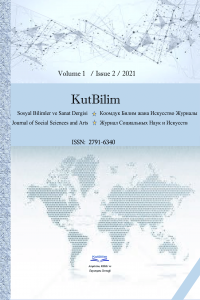AN ASSESSMENT OF THE DEMOGRAPHIC STRUCTURE OF KYRGYZSTAN
Anahtar Kelimeler:
Demographic structure, Population growth, Ethnic structure, Kyrgyzstan.
AN ASSESSMENT OF THE DEMOGRAPHIC STRUCTURE OF KYRGYZSTAN
The declines in mortality and birth rates in Kyrgyz society is associated with social and economic transformations and changes that went through in the 20th century. Although these transformations and changes brought a new way of life to the Kyrgyz society, they brought its demographic structure to new dimensions. Due to a serious decline in infant and child mortality rates in Kyrgyzstan, the population growth rate in the country increased in the second quarter of the 20th century, but then began to decline again with a decline in the birth rate. Currently, the proportion of the elderly population in Kyrgyzstan is low. While the 0-14 age group constitutes 1/3 of the total population, the working-age population has a share of approximately 60%. Therefore, the population of Kyrgyzstan has a dynamic characteristic. This feature creates an important advantage for the development and prosperity of the country. Moreover, the unique ethnic diversity in the country grants a distinctive feature to the demographic structure of Kyrgyzstan.
The aim of this study is to examine the demographic structure of Kyrgyzstan. The primary data used in the study were obtained from the United Nations Population Division and the National Statistics Committee of the Kyrgyz Republic. In addition, the reports of research institutions, and academic articles and books were used.
Keywords:
Demographic structure, Population growth, Ethnic structure, Kyrgyzstan. Demographic structure, Population growth, Ethnic structure, Kyrgyzstan.,
___
- Aprel gazetesi (2016). “Zhenshiny SSSR: Mat-Geroinya”, http://april-knows.ru/articles/zhenshchiny_sssr_mat_geroinya/ (Erişim Tarihi 03.01.2022).
- Bogue, Donald Joseph (1969). Principles of Demography, New York: Wiley.
- Bongaarts, J. (2009). Human Population Growth and the Demographic Transition. Philosophical Transactions of the Royal Society B, 364 (1532): 2985-2990.
- Dzhooshbekova, Ainagul (2013). Migratsionnye Protsessy V Sfere Kyrgyzov, Doktora tezi, Bişkek, İshenaaly Arabaev Kırgız Devlet Üniversitesi.
- Elkeeva, Kanymkul (2010). “Kyrgyzstanda 120 ulut okuldoru zhashait”, 21 Ekim 2010, Azattyk Unalgysy, https://www.azattyk.org/a/Kyrgyzstan_People/2197185.html (erişim Tarihi 22.03.2022).
- Eshnazarova, A. (2018). Afrika’nın Demografik Yapısı ve Sorunları, Yüksek lisans tezi. Ankara Üniversitesi. INS Resource Information Center (1993). “Kyrgyzstan: Political Conditions in The Post- Soviet Era”, Washington D. C., http://hrlibrary.umn.edu/ins/kyrgyz93.pdf (Erişim Tarihi 16.04.2022).
- Karazhanova, G. (2016). Kyrgyzstanda Kyrgyz Ulutunun Ulushu 73%dy Tuzot, Birinchi Radio, http://www.ktrk.kg/post/1682/kg (Erişim Tarihi 03.02.2022).
- Kirk, D. (1996). Demographic Transition Theory, Population Studies, 50 (3): 361-387.
- Kırgız Cumhuriyeti Anayasası. (1993). Bişkek.
- Kırgız Cumhuriyet Anayasası. (2010). Bişkek.
- Kırgız Cumhuriyeti Ulusal İstatistik Komitesi (KCUİK). (2022). “Kalk”. Bişkek, http://www.stat.kg/kg/statistics/naselenie/ (Erişim Tarihi 03.04.2022).
- Kırgız Cumhuriyeti Ulusal İstatistik Komitesi (KCUİK). (2022). “Kalktyn tabigyi osuusu”. Bişkek, http://www.stat.kg/kg/opendata/category/144/ (Erişim Tarihi 16.04.2022).
- Kırgız Cumhuriyeti Ulusal İstatistik Komitesi. (2022). “Kalktyn uluttuk kuramy”. Bişkek, http://www.stat.kg/kg/opendata/category/312/ (Erişim Tarihi 25.01.2022).
- Kırgız Cumhuriyeti Ulusal İstatistik Komitesi (KCUİK). (2022). “Torolgondordun sany”. Bişkek, http://www.stat.kg/kg/opendata/category/40/ (Erişim Tarihi 13.02.2022).
- Kırgız Cumhuriyeti Ulusal İstatistik Komitesi (KCUİK). (2022). “Torolgondogu omurdun kutulgon uzaktygy”. Bişkek, http://www.stat.kg/kg/opendata/category/3913/ (Erişim Tarihi 28.02.2022).
- Kırgız Cumhuriyeti Ulusal İstatistik Komitesi (KCUİK). (2022). “Turuktuu kalktyn dinamikasy”. Bişkek, http://www.stat.kg/kg/opendata/category/316/ (Erişim Tarihi 23.03.2022).
- Kırgız Cumhuriyeti Ulusal İstatistik Komitesi (KCUİK). (2022). “Turuktuu kalktyn zhynysy zhana kuraktyk toptoru boiuncha sany”. Bişkek, Kırgız http://www.stat.kg/kg/opendata/category/206/ (Erişim Tarihi 13.02.2022).
- Kudabaeva. Z., Gijo, M., ve Denisenko. M. (2004). Naselenie Kyrgyzstana, Bişkek. Natsionalnyi Statischeskii Komitet Kyrgyzkoi Respubliki.
- Nasritdinov, Emil (2016). “Pros and Cons of Migration in Kyrgyzstan”, https://www.academia.edu/4371887/Migration_in_Kyrgyzstan_-_Pros_and_Cons (Erişim Tarihi 16.02.2022). Our World in Date. (2020). “Median age, 1950 to 2020”. https://ourworldindata.org/grapher/median-age?tab=chart&year=2020&time=1950..2020&country=KGZ (Erişim Tarihi 30.03.2022).
- Ross, John (1982). The International Encyclopedia Of Population, Free Press, New York.
- Rowland, Donald T. (2003). Demographic Methods and Concepts, Oxford University Press.
- Schuler, Martin (2007). “Migration Patterns of the Population in Kyrgyzstan”, espace, populations, sociétés, (1): 73-89.
- Sputnik.kg. (2018). “Kyrgyzstandyktardyn Ortocho Zhash Kuragy Kaisy Aimakta Zhogoru Ekeni Aityldy”. https://sputnik.kg/society/20181104/1041846518/kyrgyzstandyktardyn-ortocho-zhash-kuragy.html (Erişim Tarihi 04.11.2018).
- Şahin, Salih (2007). Geçmiş, Günümüz ve Gelecekte Nüfus Gerçeği, Gazi Kitapevi, Ankara.
- United Nations. (2019). “Crude birth rate (births per 1,000 population)”, World Population Prospects 2019, Population Division, https://population.un.org/wpp/DataQuery/ (Erişim Tarihi 03.01.2022).
- United Nations. (2019). “Total Fertility (children per woman)”, World Population Prospects 2019, Population Division, https://population.un.org/wpp/DataQuery/ (Erişim Tarihi 22.03.2022).
- United Nations. (2019). “Crude Death Rate (deaths per 1,000 population)”, World Population Prospects 2019, Population Division, https://population.un.org/wpp/DataQuery/ (Erişim Tarihi 13.02.2022).
- United Nations. (2019). “Rate of Natural Increase”, World Population Prospects 2019, Population Division, https://population.un.org/wpp/DataQuery/ (Erişim Tarihi 26.01.2022).
- United Nations. (2022). World Population Prospects, Department of Economic and Social Affairs, Population Division, https://population.un.org/wpp/ (Erişim Tarihi 01.12.2022).
- Yankey, David, Anderton, Douglas L. ve Lundquist, Jennifer Hickes (2007). Demography: The Study of Human Population, Illinois: Waveland Press.
- Yüceşahin, M. Murat (2013). “Afrika: Demografik Yapı, Mekân, Sorunlar ve Gelecek”, Turkish Journal of Population Studies, (35): 31-61.
- Başlangıç: 2021
- Yayıncı: Kutbilim Araştırma, Kültür ve Dayanışma Derneği
Sayıdaki Diğer Makaleler
REPRESENTATION OF PRESCRIPTIONS OF COMMUNICATIVE BEHAVIOR IN THE KYRGYZ LANGUAGE
AN ANALYSIS OF “STANCE DEVICES” IN SOCIAL SCIENCE RESEARCH ARTICLES BY NATIVE AND TURKISH WRITERS
SELF-REGULATION DEVELOPMENT AND THE INTERNET ADDICTION: AN EFFORT TO FIND THE CONNECTION
Ekaterina SEDOVA, Tatiana GORYACHEVA
THE NATIONAL GAME OF THE KYRGYZ " KӨK BӨRU " AND ITS GENESIS
AN ASSESSMENT OF THE DEMOGRAPHIC STRUCTURE OF KYRGYZSTAN
ÂŞIK KURBÂNİ DESTANINDAKİ FİİL TEKRARLARIYLA, BAĞLAÇLARLA OLUŞAN İKİLEMELER
